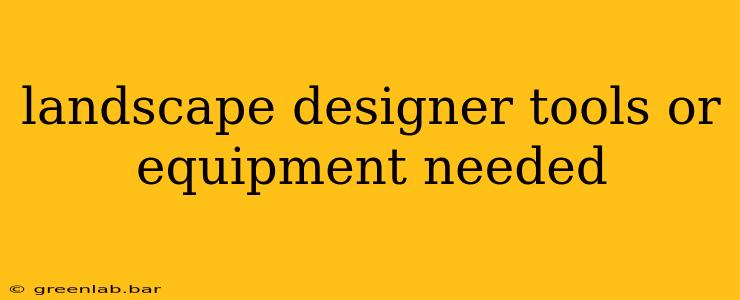Creating stunning outdoor spaces requires more than just a vision; it demands the right tools and equipment. Whether you're a seasoned professional or a passionate DIY enthusiast, having the appropriate gear significantly impacts efficiency, precision, and the overall quality of your landscape design projects. This comprehensive guide explores the essential tools and equipment needed for successful landscape design, categorized for clarity and ease of understanding.
Essential Hand Tools for Landscape Design
These tools are your everyday companions, crucial for various tasks from initial planning to final touches.
Measuring and Marking:
- Measuring Tape: A long, durable tape measure (at least 25 feet) is indispensable for accurate measurements of areas, distances, and plant spacing. Consider a wheel-style measuring tool for larger areas.
- Landscape Stakes: These sturdy stakes are used to mark out boundaries, plant locations, and design features.
- String Line: Essential for creating straight lines and defining curves, particularly for pathways, beds, and retaining walls.
- Spray Paint: For marking lines and features directly on the ground, ensuring accuracy and avoiding unnecessary alterations. Choose a color that contrasts well with your soil.
Digging and Planting:
- Shovel: A round-point shovel is perfect for digging holes for plants and moving soil, while a square-point shovel is ideal for moving larger quantities of soil and creating clean edges.
- Trowel: A hand trowel is essential for smaller planting tasks, weeding, and precise soil manipulation.
- Hand Rake: For smoothing soil, removing debris, and creating neat edges around planting beds.
- Garden Fork: Excellent for aerating soil, loosening compacted earth, and lifting heavier plants.
Pruning and Trimming:
- Hand Pruners: For precise pruning of smaller branches and stems. Bypass pruners are generally preferred for clean cuts.
- Loppers: Used for cutting thicker branches that are beyond the reach of hand pruners.
- Hedge Trimmers: For shaping hedges and maintaining neat edges on shrubs. Choose between manual or electric options based on your needs and project scale.
Power Tools for Enhanced Efficiency
Power tools significantly speed up the process and handle more demanding tasks, especially in larger projects.
Earthmoving:
- Power Auger: Facilitates efficient and accurate hole digging for larger plants and posts, saving significant time and effort.
- Trench Shovel: Ideal for digging long, narrow trenches for irrigation systems, drainage, or underground utilities.
- Mini Excavator (optional): For large-scale projects or extensive earthmoving, a mini excavator offers unmatched power and efficiency.
Cutting and Trimming:
- Chainsaw (optional): Needed for larger tree removal or trimming significant branches. Safety precautions are paramount when using a chainsaw.
- String Trimmer/Weed Eater: Essential for maintaining neat edges around walkways, flower beds, and other landscaped areas.
Other Essential Landscape Design Equipment
Beyond the tools, several pieces of equipment boost productivity and refine the landscaping process.
- Wheelbarrow: For transporting soil, mulch, gravel, and other landscaping materials efficiently.
- Tarps: Protect plants, soil, and other materials from weather elements and provide a clean working surface.
- Gloves: Protecting your hands from dirt, thorns, and potential injuries is crucial. Choose durable and comfortable work gloves.
- Kneeling Pad: Provides comfort and support during prolonged periods of kneeling or working on the ground.
- Safety Glasses and Hearing Protection: Essential for safeguarding your eyes and ears, particularly when using power tools.
Choosing the Right Tools: A Practical Approach
Selecting the right tools depends heavily on the scale and scope of your landscape design projects. For small residential projects, the essential hand tools will likely suffice. Larger commercial or extensive residential projects will benefit significantly from investing in power tools and other equipment.
Remember, prioritizing safety and proper tool maintenance are paramount to ensuring both efficiency and longevity. Investing in quality tools will pay off in the long run, resulting in better results and a safer working environment. This guide provides a solid foundation for equipping yourself for successful landscape design endeavors.

